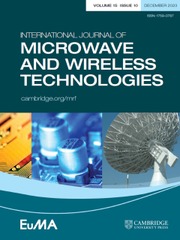No CrossRef data available.
A Chebyshev-distributed 1 × 8 beamforming network with improved phase flatness for low sidelobe and consistent beam pointing applications
Published online by Cambridge University Press: 31 July 2025
Abstract
A Chebyshev-distributed 1 × 8 beamforming network with improved phase flatness is presented, where four beams with constant beam pointing and low sidelobe levels (SLL) can be generated. It consists of two arbitrary-amplitude 4 × 4 Blass-like matrices and one 1 × 8 switch control circuit. The newly introduced 4 × 4 Blass-like matrices can obtain arbitrary amplitude and phase differences by adjusting the transmission coefficient and phase of each unit. Besides, four output phase differences can be generated by controlling the 1 × 8 switch control circuit. An example is implemented for validation and phase compensation method is adopted for minimizing the phase difference error within the operated bandwidth to maintain constant beam pointing. Measurements show that the prototype exhibits output amplitude ratios of 0.143:0.341: 0.71:1:1:0.71:0.341:0.143, which fits the Chebyshev distribution. Under the criterion of |S11| < −10 dB, an overlapped fractional bandwidth of 24.1% is obtained. In addition, from 5.5 to 6.1 GHz (10.3%), the maximum amplitude and phase difference errors are 1.5 dB and 15°, respectively. Finally, the proposed network is connected to a 1 × 8 array. Within 10.3% bandwidth, the SLLs of less than −20 dB are realized without beam-pointing deviation.
Keywords
Information
- Type
- Research Paper
- Information
- International Journal of Microwave and Wireless Technologies , Volume 17 , Issue 4 , May 2025 , pp. 673 - 682
- Copyright
- © The Author(s), 2025. Published by Cambridge University Press in association with The European Microwave Association.


